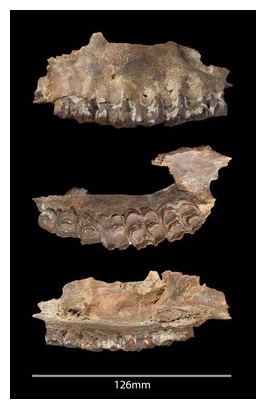Researchers from Max Planck Institute for the Science of Human History have unearthed 300,000-year old stone tools in Saudi Arabia, providing new insights into earliest hominin migrations into the Arabian Peninsula. The study suggests that dispersal of hominin beyond Africa did not involve adaptations to environmental extremes, such as to arid and harsh deserts.
Today, Arabian Peninsula region is characterized by largely hyper-arid and inhospitable climate. However, this region had somewhat different climate thousands of years ago. In the recent past, 90000-year-old fossils of a member of Homo sapiens were discovered in northern Arabia. In the current study, researchers carried out excavations at the site of Ti’s al Ghadah, in the Nefud Desert of northern Saudi Arabia, and unearthed some stone tools in a sandy layer of soil beneath the dry traces of a shallow Pleistocene lake. Researchers also got evidence for the butchery of animals on bones. There were cut-marks on fossil animal remains. The soil layer from which stone tools were discovered was found to be between 300,000 and 500,000 years old. These findings confirmed that hominin lived in this region about 500,000 to 300,000 years ago (at least 100,000 years earlier than previously known).
#Archaeologists find 300,000-year-old stone #tools in Saudi Arabia#SaudiArabiahttps://t.co/jEkCcfHKaS pic.twitter.com/lkEY6o2ziQ
— Oden (@Gjallarhornet) October 29, 2018
Ti’s al Ghadah is a highly significant paleontological site in the Arabian Peninsula.
“It currently represents the only dated collection of middle Pleistocene fossil animals in this part of the world, and includes animals such as elephant, jaguar and water birds,” said Mathew Stewart, one of the lead authors of the study.
The team applied geochemical methods, including stable isotope technique, to fossil animal tooth enamel to determine vegetation and aridity conditions associated with the movements of our ancestors into this region.
The findings revealed the animals in the region had enough grass to eat at that time, and the aridity levels here were similar (to some extent) to those experienced in East Africa ‘savanna’ settings today. The region also had ample water availability for animals at certain points in time. The results indicate that early dispersals of our archaic ancestors were part of a range expansion rather than a result of novel adaptations to new environmental contexts outside Africa.
“This makes Ti’s al Ghadah the first, early hominin-associated fossil assemblage from the Arabian Peninsula, demonstrating that our ancestors were exploiting a variety of animals as they wandered into the green interior,” said Michael Petraglia, the principal archaeologist of the project and a co-author on the paper.
“While these early hominin populations may have possessed significant cultural capacities, their movement into this part of the world would not have required adaptations to harsh and arid deserts,” Dr. Patrick Roberts, the lead author of the paper, explains.
“Indeed, the isotope evidence suggests that this expansion is more characteristic of a range expansion similar to that seen among other mammals moving between Africa, the Levant, and Eurasia at this time,” Dr. Roberts added.
Detailed findings of the study have been published in Nature Ecology and Evolution.

